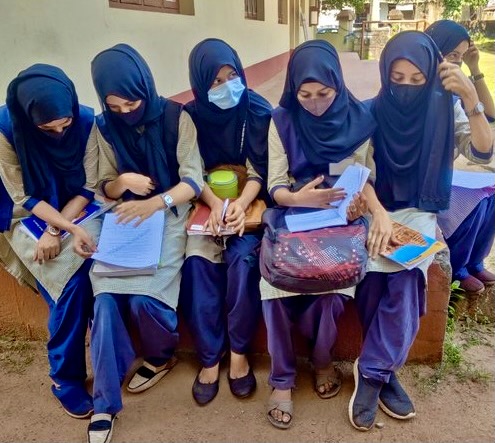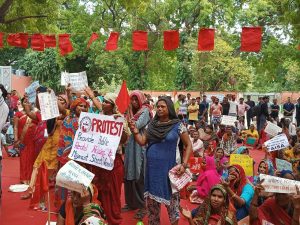Hijab Ban In Udupi College Points To Growing Communal Fissure

For over three weeks now, eight Muslim students of the Government Pre-University College (PUC) for Girls in Udupi, Karnataka, have been sitting outside their classrooms with their bags and books. The college has banned the hijab, the head scarf worn by some Muslim women, in classrooms, and the second-year students have no choice but to study in the college corridors.
Female Muslim students wearing a hijab are still not allowed inside the classrooms and being marked ‘absent’ as the Government PU College in Udupi has denied them entry since 3 weeks!
— Rabia Shireen (@rabiasyed97) January 15, 2022
"They asked us to sit on stairs. It's uncomfortable and humiliating."#HijabisOurRight pic.twitter.com/69RT0Gpj16
The college has a prescribed uniform and the hijab violates this dress code, authorities say. The girls counter that they cannot be denied the right to dress as required by their religion and they are uncomfortable being around men without the hijab. The stand-off has now spilled into social media where it is being aggressively debated.
Muslim female students, just for wearing hijab, have not been allowed to enter the classroom of a government run college for the last 3 weeks in Udupi, India! Is this still a secular India?
— S.K.M.A.Sheikhabdullah (@sheikabdullah27) January 16, 2022
We need 1st secular india,
Like a tamilnadu,like a kerala,some other states too
I have no idea why a college has banned hijabs. Seems unjustified
— Uncle G (@NamelessUncle) January 15, 2022
If a Sikh can wear a turban, a hindu can wear their traditional attire, why can't Muslims.
We were unhappy about a hotel not allowing Saree weren't we few months ago #Udupi #UdupiStudentsNeedJustice
Aliya Assadi (17), a second-year student of the college, alleges that college authorities are not being transparent in the debate. “During our first year, when we had offline classes for two months, we started wearing the hijab to our lectures. The principal and teachers told us that we were violating the terms and conditions [of college admission] and our parents agreed that we would not wear the scarf. But we found out later that there was no such condition,” says Assadi.
College principal Rudra Gowda has said that the students can wear hijabs in the school premises, but not inside the classrooms. The girls asked their parents to point out to the principal that the college had no rules on the issue but they were ignored. “That is when we decided to wear the hijab regardless. It is our constitutional right, anyway,” says Assadi.
Almas, another second-year student who goes by just one name, told BehanBox that the girls were denied entry into classrooms despite repeated requests. “When we tried attending lectures, our professor threatened to push us out. We have been made to stand outside ever since. They would not even mark our attendance,” she says.
This is not the first instance of a college attempting a hijab ban in the region in recent times. In 2019, a student of St Agnes in Mangaluru was denied readmission to the college after she refused to take off her hijab in the classroom. This is despite the fact that she had attended her classroom lectures wearing the hijab throughout her first year.
The hijab ban and the response of the eight students at Udupi has caused ripples in neighbouring districts too. Student members of various right-wing Hindutva outfits in at least two other colleges wore saffron scarves in protest against Muslim students wearing hijab to college. For instance, several students turned up wearing saffron scarves at the Balagadi Government Degree College in Koppa taluk of Chikkamagaluru district. They threatened to escalate the “protest” if the matter was not addressed.
On January 12, it was decided that both saffron scarves and hijabs will be banned inside the Balagadi campus. However, Muslim girls will be allowed to use a shawl to cover their heads. Principal Anantha Murthy has also said that anyone violating the rule will lead to dismissal.
The college dress code has also been suspended till a decision can be reached at the next parent-teacher meeting.
#Chikmagalur: Students of first class college in Koppa taluk have taken saffron to protest against Muslim students coming to college wearing #hijab #Karnataka #MuslimGirls
— Hate watch Karnataka (@Hatewatchkarnat) January 3, 2022
another day in #Karnataka college 😑 pic.twitter.com/GNdGnTj9rU
BehanBox has been attempting to speak to the Udupi college authorities on the controversy and this story will be updated when they respond.
A hijab ban is a violation of every Indian’s fundamental right to practise his/her religion, says senior Supreme Court advocate Sanjay Hegde. “I don’t think any institution would tell a Sikh boy to not wear a turban, nor can an institution tell a Brahmin student not to wear the sacred thread. These are essential religious beliefs,” Hegde points out. “So if a Muslim woman student were to go to court and say that this (the hijab) is an essential religious belief because it has been laid down in the Qur’an, there would be a case for the authorities that seek to ban the hijab to answer why this cannot be allowed as part of the uniform.”
national committee member Countries around the world that have banned the hijab in educational institutions have been criticised for laying the “groundwork” for racism, hatred and fear and for obstructing the economic and social integration of Muslim women. A 2020 Stanford study on the hijab ban in France found that it affected the ability of Muslim girls to finish school, doubling the education gap between them and the others. The study also found that this impact extends to even those Muslim students who do not sport the hijab.“Such restrictions can force many girls to either take admission in colleges that may or may not offer their preferred subjects or drop out entirely,” says Shahida Aslam, social activist and national committee member of National Women’s Front.
Growing divide
Sharply polarised conversations around the hijab are not new to the region (see here, here, and here). The coastal districts of Dakshina Kannada and Udupi (also formerly a part of Dakshina Kannada) are a stronghold of Hindu nationalist organisations and have a long history of communal tensions, as chronicled by local journalists.
Social activist Vidya Dinker believes that polarisation is pushing all communities into taking extreme positions. “The kind of public posturing we are witnessing – a situation where those wearing saffron scarves are threatening disorder and Muslims girls, in turn, point to Hindu girls wearing bangles and bindis to college – it brings more fiction than praxis in our society,” says Dinker.
In an apparent defence of the saffron scarf protest, Karnataka education minister BC Nagesh said it was only a “reaction” to Muslim students’ insistance on wearing the hijab. Some students at Pompei college, Aikala, in Mangalore, too wore saffron scarves to college on January 6 as a mark of “protest”.
After #chikmagalur now Pompel college students are protesting #Mangalore have started protest demanding- if #Muslim girls are allowed to wear #Hijab inside college. Then, they should also be allowed to wear SaffronScarf. #Karnataka. pic.twitter.com/IzySEPVgD8
— Hate watch Karnataka (@Hatewatchkarnat) January 6, 2022
Following an emergency coordination committee meeting on January 7, Pompei college principal Purushothama KV said both hijabs and saffron scarves would be disallowed on the campus. He also pointed out that Muslim students of the college had been attending classes wearing the hijab for over the last five years and nobody had objected till now.Meanwhile, the impasse at the Udupi college has yet to be resolved. “The management needs to understand that even if it’s an all-girls’ college, there are male professors. These students are not comfortable taking off their hijabs in the presence of male teachers,” argues Masood Manna, state committee member of Campus Front of India, a student’s organisation that is backing the Muslim students’ right to wear the hijab.
Ban is ‘inconsiderate’
A student’s choice to wear the hijab is personal and should not concern college authorities, says Fathima Usman, a first-year student of Bachelor of Ayurvedic Medicine and Surgery at Karavali College, Mangalore, and state committee member of CFI in Karnataka. “The Indian Constitution has given these girls the right to practise their religion and nobody can take it away from them. And it does not hinder their learning. Why should the teachers interfere?” she says.
In 2015, the Supreme Court had refused to ease the scarf ban for students appearing for the All India Pre-Medical Test (AIPMT) stating that the “faith is not in the scarf”. The plea was subsequently withdrawn. The SC directive came after Kerala High Court allowed two Muslim girls to wear a headscarf and a full-sleeve dress for the test.
Lawyer Sanjay Hegde said that there is merit in the argument that the scarf can obstruct invigilation during exams. “However, to say that students cannot wear hijab throughout the year while they are attending classes may be grossly disproportionate,” he says.
High Court advocate Abha Singh called the hijab ban “inconsiderate”. “According to a Madras High Court order, a restriction on the fundamental right to practise one’s religion may only be placed when it affects public order, morality and health. In that case the hijab is a part of their personal religion and is not adversely affecting anyone,” she says.
Inflammatory statements
Observers say the communal lines started growing sharper in the region after the Babri Masjid demolition. “While the identity markers for the indigenous Beary Muslims in the region were very different before the 90s, they changed in the aftermath of the Babri Masjid demolition. As the minority Muslim community started feeling threatened, they started using markers (like the burqa) to embrace an identity that would bring them together as a community and offer a sense of protection and solidarity,” says journalist Greeshma Kuthar, who has written extensively on the region’s communal divisions. The Hindutva brigade eventually started using these evolving markers to “otherise” the Beary Muslims, she adds.
“So even though these narratives around burqa and hijab have been propagated by organisations like Bajrang Dal, VHP and Ram Sene through public platforms over the past decades, they were not mainstream. It is the current political atmosphere and state endorsement which has fanned the flames and ensured that these conversations don’t die down,” says Kuthar.
Dinker also believes that the anti-Muslim sentiment has been fanned by the fact that there is no action against leaders who make inflammatory statements. “Political leaders in the state have regularly made uncontested patriarchal statements from all stages and press conferences and get away with it. And this has been normalised because members of the press would not even question them,” she says.
There have been allegations that Muslim students at the Udupi college are not allowed to communicate with each other in Urdu or Beary, the language spoken mostly by the Muslims in the region, and that they are being pressured to join activities of the Akhil Bharatiya Vidyarthi Parishad (ABVP), the student wing of Rashtriya Swayamsevak Sangh. However, BehanBox could not independently verify these allegations.
Aslam believes that ever since the BJP came to power in Karnataka, polarisation around the issue of hijab has grown, especially in government colleges. “While the hijab ban had been in place in Christian colleges like St Agnes College, it is only under the BJP regime that the issue has started cropping up increasingly in government colleges as well,” she says.
The hijab ban can not be seen in isolation, says activist Aslam, because it is also an attempt to alienate Muslims, especially Muslim women. “They’re not only being told what they can and cannot wear, but also who they can be friends with. They (Hindutva outfits) want to prevent youngsters of different communities from mixing with each other,” she points out.
Several cases of moral policing from the Dakshin Kannada region have been reported in recent years. In November 2021, Mohammad Yasin (20), a student, was assaulted for dropping home his female friend and classmate who belongs to another religion. In another instance, Bajrang Dal members stopped a group of medical students on their home from Malpe beach and harassed the women for being in the company of Muslim men.
These incidents are detrimental for women’s rights, says Aslam. “These Hindutva organisations want women to know that they can not exercise their freedom. This vigilantism is their way of threatening women who do not follow their diktat,” she says.
We believe everyone deserves equal access to accurate news. Support from our readers enables us to keep our journalism open and free for everyone, all over the world.




